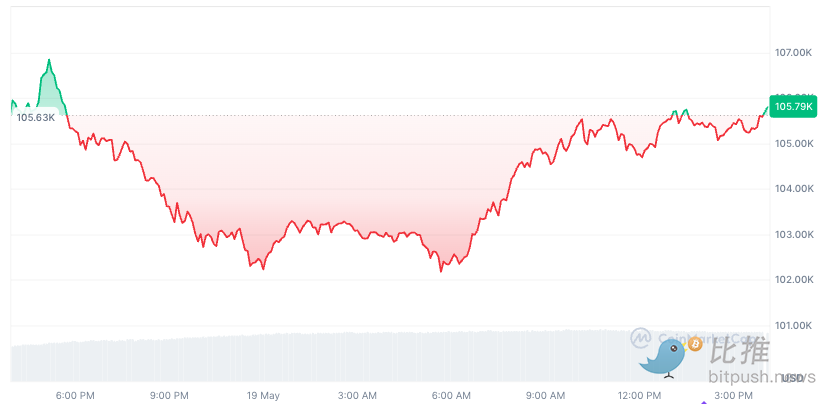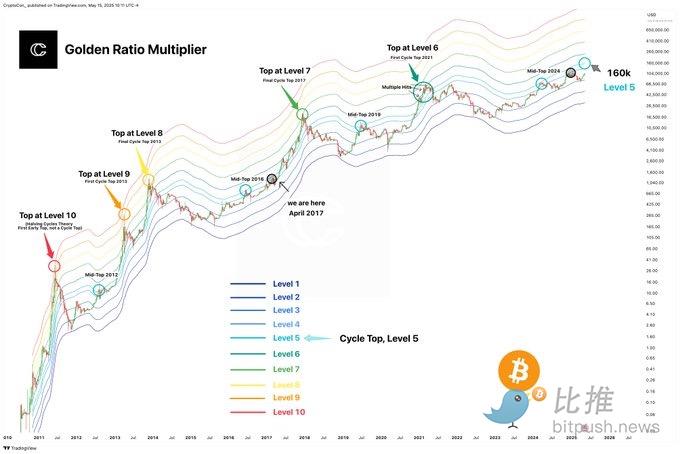Written by: BitpushNews
On Monday, the cryptocurrency market continued a slight rebound, with Bitcoin briefly touching a daily high of $107,068 before falling back to around $102,105. According to CoinMarketCap data, at the time of writing, Bitcoin was trading at $105,850, with less than 1% fluctuation in 24 hours, and a 40% increase in 24-hour trading volume to $64.63 billion.

"Ten Thousand Dollar Ladder-like Rise" Pattern
Some market observers noted an interesting "ladder-like" pattern in Bitcoin's recent rise.
Analyst Trader Tardigrade discovered that BTC price increases show a periodic pattern, with each upward wave around $10,000, followed by a brief pause. He mentioned the movement from $75,000 to $85,000, then to $95,000, and recently to $105,000. After each jump, there is usually seven to ten days of relatively calm sideways consolidation.

For traders, this pattern offers predictable opportunities to take profits or establish new positions. These consolidations can serve as new support levels, indicating buyers' willingness to re-enter. If this pattern continues, the next logical target could be $115,000, which is about 11% higher than the current price.
Tardigrade believes the $100,000 mark is significant. This round number is not only an important psychological defense line but also forms a strong technical support. It's worth noting that after an 11% surge in early May, Bitcoin still maintained a modest 0.5% increase last week, a "slow bull" characteristic that appears healthier and more sustainable compared to violent fluctuations.
$160,000 Target
Looking further ahead, chart analyst CryptoCon provided a more optimistic outlook using the "Golden Ratio Multiplier" model.

CryptoCon stated that the Golden Ratio Multiplier model was one of the few technical indicators that accurately predicted the Bitcoin cycle top in April 2021.
According to the model's analysis, in March 2024, the market has already reached the mid-cycle top, meaning it will likely test the top again. Currently, the model shows the fifth-level target pointing to $160,000 and continuing to rise, a trend quite similar to the 2015-2017 bull market cycle - the current stage is equivalent to the position in April 2017, just before the main bull market wave. Historical experience suggests that this slow accumulation phase often indicates a potential accelerated upward trend.
It's worth noting that while this technical analysis has some reference value, the $160,000 target is based on calculations from a specific model, and the actual trend may be influenced by various factors. For ordinary investors, understanding these cycle characteristics can help grasp market rhythm, but more importantly, manage risks.
Willy Woo: BTC Compound Annual Growth Rate Will Stabilize at 8%
Analyst Willy Woo offered another perspective. He believes Bitcoin has evolved from a highly volatile, explosive growth asset to a more mature financial instrument. Although many still view Bitcoin as a constantly soaring "magical unicorn," Woo points out that the era of over 100% annual growth rates seen in 2017 has essentially passed. He marks 2020 as a key turning point when Bitcoin became "institutionalized" as companies and sovereign entities began accumulating it.

With more institutional capital entering, Bitcoin's compound annual growth rate (CAGR) naturally dropped from three digits to around 30%-40% and continues to moderate. Woo attributes this to Bitcoin's increasing maturity and its growing role as a capital store. He emphasizes Bitcoin's position as a global financial asset, noting that it "will continue to absorb capital until it reaches its equilibrium point."
Looking further ahead, Woo predicts that Bitcoin's compound annual growth rate will ultimately stabilize at a level consistent with broader economic trends, potentially around 8% annually (combining 5% long-term monetary expansion and 3% GDP growth). Although this growth rate may seem insignificant compared to earlier periods, he remains confident in its long-term performance, concluding: "Enjoy the journey until then (perhaps 15-20 years), because almost no publicly investable product can match Bitcoin's performance long-term, even as its compound annual growth rate continues to decline."






